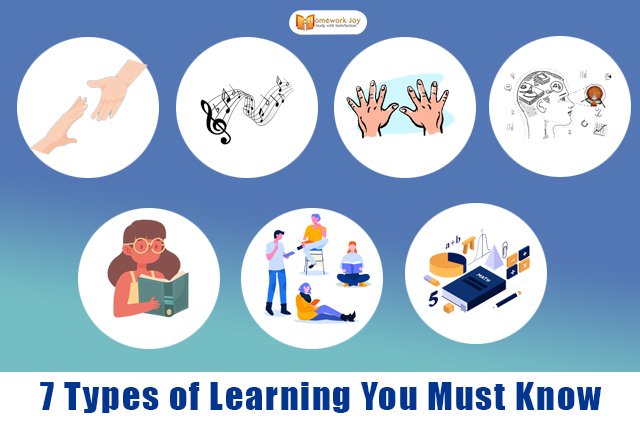Learning is a widely used term and commonly heard everywhere. We keep on learning throughout our lives. It’s a never-ending process. It is interesting to know that learning has no age bar. From child to adult, anyone can learn and acquire knowledge. Before proceeding to the various types of learning, let us first know what the meaning of learning is.
Learning refers to the change as a result of experiences, which increases the potential for improved performance. The difference may happen regarding knowledge, attitude, or behavior. Learning is something not done to students, but students themselves do. It is the result of how students interpret and respond to different experiences. If we compare simple ways in which a child behaves with a complex form of adult behavior, their skills, habits, thoughts, etc. then we will get to know what difference learning makes to an individual. The definition has three essential elements :
- Learning is a change in behavior be it better or worse
- The change in behavior takes place through experience.
- The change in behavior is permanent and lasts for a long time.
Common Types of Learning
The activities learned by an individual refer to the types of learning. The events are either physical or mental activities. There may be simple activities or complex activities. Various types of learning activities, according to the learners, are there.
Visual learning
Are you the one who understands the concept better through diagrams and a web chart? Then you might be a visual learner. Visual learning involves a change in behavior by seeing and adapting the same. It is the type of learning where knowledge or concept maps is better used. Visual learners often pursue a career in architecture, engineering, design, etc.
Aural (Musical)learning
It is the type of learning where hearing plays a significant role. Learning which involves noticing pitch, tone, etc. is used here. A person can be an aural learner if they understand things better by hearing rather than seeing. Group discussions are a great and helpful way to grasp new ideas for auditory learners. In this learning, an individual can pursue a career such as music, speech pathologist, recording engineer, etc.
Physical(Kinesthetic) learning
In this style, learning happens when a person takes an interest in physical activity rather than listening to a lecture. It is also known as a kinesthetic type of learning. They are do-ers and prefer hands-on learning. The careers that kinesthetic learners can opt for our emergency services, physical education, entertainment, etc.
Logical (Mathematical) learning
As the name suggests, it is the learning where an individual uses the brain and logic behind every question. One needs to be connected to the numbers and have a curiosity behind every fact. The career for logical learners is accountancy, bookkeeping, scientific research, etc.
Verbal (Linguistic) Learning
Linguistic learning refers to the way a person learns to express themselves. A person can express either by writing or speaking. When an individual loves to write and play tongue twisters, then he is said to be a linguistic learner. Usually, some children learn better by speaking loudly. The career pursued by verbal learners is often public speaking, writing, journalism, or politics.
Social (Interpersonal) Learning
Social learning is a type of learning when an individual see a change in behavior when they are socializing. If a person is best at socializing verbally or non-verbally, then they are said to be a social learner. They can pursue a career in counseling, teaching training, sales, and others.
Solitary (Intrapersonal) Learning
It is a type of learning where an individual prefers to learn in solitude. Your concentration is best when you focus on your feelings. Authors and researchers have a robust intrapersonal learning style.
What are the Theories of Learning?
Theories of learning refer to a set of principles that explains how individuals acquire knowledge. By studying theories, we can better understand how learning occurs. The methods of learning are essential for those who want to become teachers, especially.
There are five types of theories of learning:
Behaviorism
Behaviorism is a work of B.F Skinner, and he proposed the concept of operant conditioning. Behaviorists believe that learning occurs when a new behavior is acquired through the association between stimuli and response. Behaviorists believe that the learner is a blank state and should be provided with the information.
Cognitivism
The theory of learning, including cognitivism, is propagated by Jean Piaget. Cognitive theorists believe that learning occurs through the internal processing of information. The focus of behaviorists is what goes inside the learner’s head through mind instead of through observable behavior. Thus the theory of learning involves reorganization of experiences.
Constructivism
The theory of learning is based on the principle that a child constructs their knowledge through individual experiences and prior knowledge. The learners build knowledge, and everyone has a different set of skills.
Experientialism
The experientialism theory of learning states that a child learns through experiences. David Kolb propagates the method, which was influenced by the work of Jean Piaget.
Social and Contextual
According to the social theory of learning, an individual learns through observation. Learning in an individual occurs through social interaction, and it can take place at any time. The primary source of socialization for a child is family, and next comes the school.
The word learning is often misunderstood. According to various learners, types of learning are distinguished. The need to know about various types is to understand how an individual changes as a result of experiences.
If you need more help related to similar topics, take instant online homework help from our professors.
